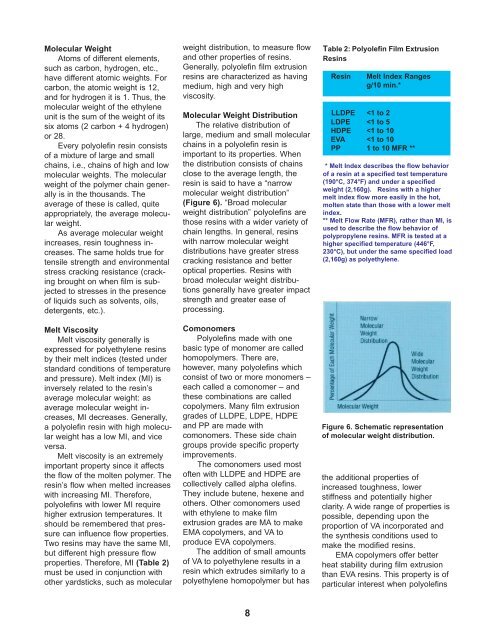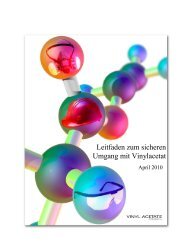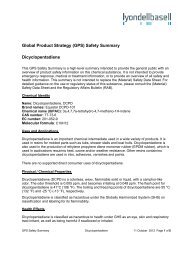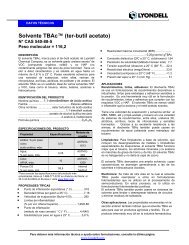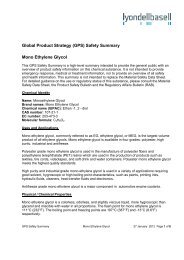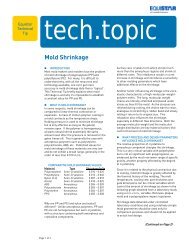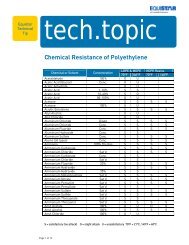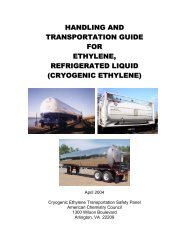Film Extrusion Guide.pmd - LyondellBasell
Film Extrusion Guide.pmd - LyondellBasell
Film Extrusion Guide.pmd - LyondellBasell
You also want an ePaper? Increase the reach of your titles
YUMPU automatically turns print PDFs into web optimized ePapers that Google loves.
Molecular Weight<br />
Atoms of different elements,<br />
such as carbon, hydrogen, etc.,<br />
have different atomic weights. For<br />
carbon, the atomic weight is 12,<br />
and for hydrogen it is 1. Thus, the<br />
molecular weight of the ethylene<br />
unit is the sum of the weight of its<br />
six atoms (2 carbon + 4 hydrogen)<br />
or 28.<br />
Every polyolefin resin consists<br />
of a mixture of large and small<br />
chains, i.e., chains of high and low<br />
molecular weights. The molecular<br />
weight of the polymer chain generally<br />
is in the thousands. The<br />
average of these is called, quite<br />
appropriately, the average molecular<br />
weight.<br />
As average molecular weight<br />
increases, resin toughness increases.<br />
The same holds true for<br />
tensile strength and environmental<br />
stress cracking resistance (cracking<br />
brought on when film is subjected<br />
to stresses in the presence<br />
of liquids such as solvents, oils,<br />
detergents, etc.).<br />
Melt Viscosity<br />
Melt viscosity generally is<br />
expressed for polyethylene resins<br />
by their melt indices (tested under<br />
standard conditions of temperature<br />
and pressure). Melt index (MI) is<br />
inversely related to the resin’s<br />
average molecular weight: as<br />
average molecular weight increases,<br />
MI decreases. Generally,<br />
a polyolefin resin with high molecular<br />
weight has a low MI, and vice<br />
versa.<br />
Melt viscosity is an extremely<br />
important property since it affects<br />
the flow of the molten polymer. The<br />
resin’s flow when melted increases<br />
with increasing MI. Therefore,<br />
polyolefins with lower MI require<br />
higher extrusion temperatures. It<br />
should be remembered that pressure<br />
can influence flow properties.<br />
Two resins may have the same MI,<br />
but different high pressure flow<br />
properties. Therefore, MI (Table 2)<br />
must be used in conjunction with<br />
other yardsticks, such as molecular<br />
weight distribution, to measure flow<br />
and other properties of resins.<br />
Generally, polyolefin film extrusion<br />
resins are characterized as having<br />
medium, high and very high<br />
viscosity.<br />
Molecular Weight Distribution<br />
The relative distribution of<br />
large, medium and small molecular<br />
chains in a polyolefin resin is<br />
important to its properties. When<br />
the distribution consists of chains<br />
close to the average length, the<br />
resin is said to have a “narrow<br />
molecular weight distribution”<br />
(Figure 6). “Broad molecular<br />
weight distribution” polyolefins are<br />
those resins with a wider variety of<br />
chain lengths. In general, resins<br />
with narrow molecular weight<br />
distributions have greater stress<br />
cracking resistance and better<br />
optical properties. Resins with<br />
broad molecular weight distributions<br />
generally have greater impact<br />
strength and greater ease of<br />
processing.<br />
Comonomers<br />
Polyolefins made with one<br />
basic type of monomer are called<br />
homopolymers. There are,<br />
however, many polyolefins which<br />
consist of two or more monomers –<br />
each called a comonomer – and<br />
these combinations are called<br />
copolymers. Many film extrusion<br />
grades of LLDPE, LDPE, HDPE<br />
and PP are made with<br />
comonomers. These side chain<br />
groups provide specific property<br />
improvements.<br />
The comonomers used most<br />
often with LLDPE and HDPE are<br />
collectively called alpha olefins.<br />
They include butene, hexene and<br />
others. Other comonomers used<br />
with ethylene to make film<br />
extrusion grades are MA to make<br />
EMA copolymers, and VA to<br />
produce EVA copolymers.<br />
The addition of small amounts<br />
of VA to polyethylene results in a<br />
resin which extrudes similarly to a<br />
polyethylene homopolymer but has<br />
8<br />
Table 2: Polyolefin <strong>Film</strong> <strong>Extrusion</strong><br />
Resins<br />
Resin Melt Index Ranges<br />
g/10 min.*<br />
LLDPE


